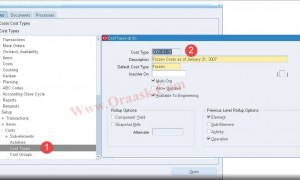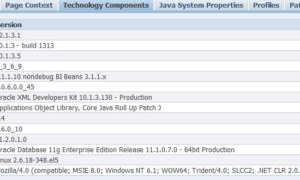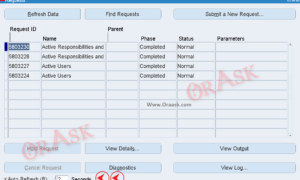$FLEX$ and $PROFILES$ are Special Variables in oracle Apps environment and are used to hold values at runtime.
Every Oracle Apps technical consultant will be familiar with the term $FLEX$ and $PROFILES$. Whenever we are working with value sets, we will be using both of these for modifying the data fetched, for basing the values of a parameter on the other parameter and also fetching the Profile Option values
You may also interested in article How to Create Profile Option in Oracle APPS.
To segregate this based on the functionality
$FLEX$: Used for basing the value of a parameter on another parameter.
$PROFILES$: used for fetching the data stored in the specified profile option value which is currently active.Where is it used?
Syntax:
:$FLEX$.previous_value_set_name
Important:
- $FLEX$ must always be in capitals.
- A ‘:’ must precede the declaration of $FLEX$.
- The previous value set name must have already been assigned and saved on a different parameter.
:$PROFILES$.Profile_option_name
Important:
- $PROFILES$ must be always in capitals.
- ‘:’ must always precede the declaration.
- Profile option name is the Profile Name and not to be confused with the User profile Name.
Some use of the Special Variables are as below:
Pre-Requisites:
Created an Executable and a concurrent program which is registered in the Application Object Library. The Query for the report is as below:
SELECT e.ename, e.empno, e.sal, e.hiredate, e.deptno, d.dname, d.loc FROM emp e, dept d WHERE d.deptno = :x_deptno; The name of the concurrent program is taken as “XX_Checking_flex_and_profile_use”
Scenario 1:
Changing the value of Parameter B based on the Parameter A:
In this, we created two value sets and they are: XX_SCENARIO_1 and XX_Sub1
Steps:
Create the value set XX_SCENARIO_1using the validation type as ‘Table’.
Create the second value set XX_Sub1 using the validation type as ‘Table’ and in the where clause field specify the following code:
where deptno <= :$FLEX$.XX_SCENARIO_1
Working:
To check the working of this concurrent program, lets submit this
In the picture here, the First parameter contains no value, so the second parameter is disabled as the WHERE clause in value set is equated to NULL, making the field disabled.
When a value is selected in the first parameter, the second parameter gets enabled and when the LOV is clicked, it shows the departments which are in department number 20 and below it, as we have specified <= in the where clause.
Scenario 2:
Steps:
The query used in the Default Value test field is as below: Select dname from dept wheredeptno =:$FLEX$.XX_SCENARIO_1
Ensure that the default value for the field Department Number is given as SQL Statement.
Select deptno fromdept where deptno=20
Working:
Lets submit the concurrent program and check.
Since the default value was given as a SQL statement, the result of that is shown in the first parameter and the second parameter has the value based on the first parameter as specified in the SQL statement.
Scenario 3:
Use of $PROFILES$ in where clause and Default Value. It is done in the same way as is used in $FLEX$.
Modifying the where clause using $PROFILES$ returns Successful upon validation.
Scenario 4:
Use of Parameter name instead of a value set name in the $FLEX$ Special Variable.
Where Clause of the value set of table type using the parameter name.
Reason:
When we provide the name of the value set in $FLEX$ then we will be able to change the value of the parameter which is dependent on it. If the value set is used by more than one parameter then it becomes difficult to get the exact value in the dependent parameter as it will fetch the values based on the last used value of the value set. It could have been last used by the first parameter or any other parameter in the form. To avoid this kind of confusion, the alternative is to provide the name of the Parameter itself in the $FLEX$ variable. No matter how many times the value set is used, if we provide the parameter name, we will get the dependent parameter value based on its parent parameter only. Let me explain this using the pictures below:
Where Clause of the value set of table type using the parameter
name.
The first and third parameter are based on value set names and the second and fourth parameter are based on parameter name. Since the second parameter is not initialized, the third parameter (value set based )is also not initialized.
Since the latest value is from Second parameter, hence the value in third is based on the second parameter. The third value is based on the value of the second parameter and is irrespective of the value set. Shown in the next picture.
Here the third parameter takes the latest value of the value set, hence shows the department name corresponding to that and the fourth parameter values are dependent on the value of the second parameter.
:$FLEX$.Previous Parameter VAlue set Name.
For Ex: We have two Parameters
Supplier Name : Table Value set
Supplier Site Code : Table VAlue set
based on the Suplier name we are suppose to get the Site codes in the Second parameter
SELECT VENDOR_NAME FROM PO_VENDORS – First VAlue set
SELECT VENDOR_SITE_CODE FROM PO_vendor_sites_All -Second Value Set
where vendor_name = Whatever user has selected in the First PArameter
(To get this value we will use :$FLEX$.Previous Value set name).
23SUPPLIER – First Value set Name
23SITE
WHERE VENDOR_ID IN(SELECT VENDOR_ID
FROM PO_VENDORS
WHERE VENDOR_NAME = :$FLEX$.23SUPPLIER)
:$PROFILES$: This will be used to Get the Profile value in the Table Value set or
from the front end.
To get Profile values from backend we are using Fnd_Profile.Value or Fnd_Profile.get()
Syntax : :$PROFILES$.Profile NameSELECT SEGMENT1
FROM PO_HEADERS_ALL22USER : 204
23USER : 887
24USER : 911
SELECT SEGMENT1
FROM PO_HEADER_ALL
WHERE ORG_ID = :$PROFILES$.ORG_ID
Ex: Display the PO’s which are created by the current User
If 22user ope the LOV it has to display the PO’s which are created by 22 user
SELECT SEGMENT1
FROM PO_HEADERS_ALL
WHERE CREATED_BY = :$PROFILES$.USER_ID
Now if you want to watch and Download this article in PDF :: Clickhere – Download Now



